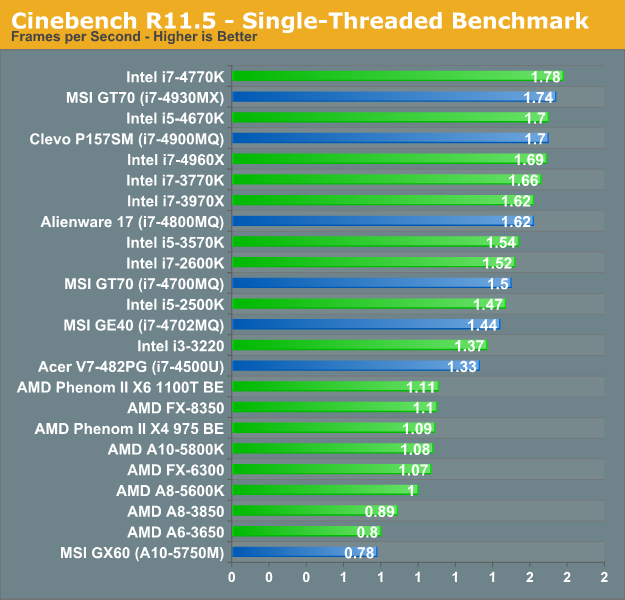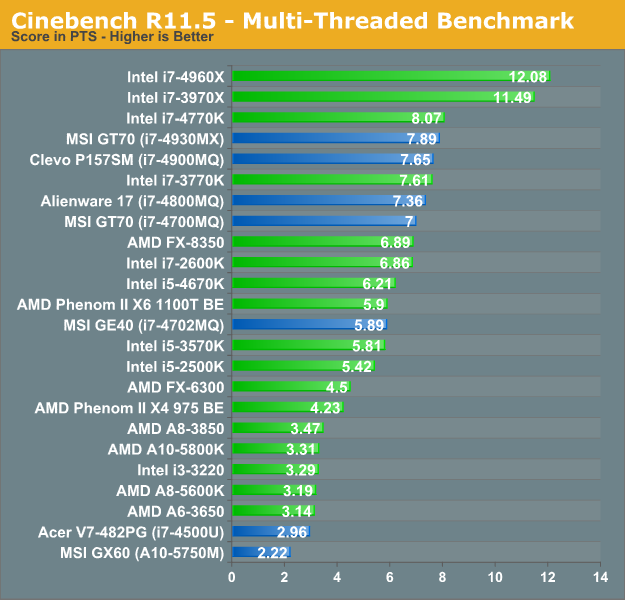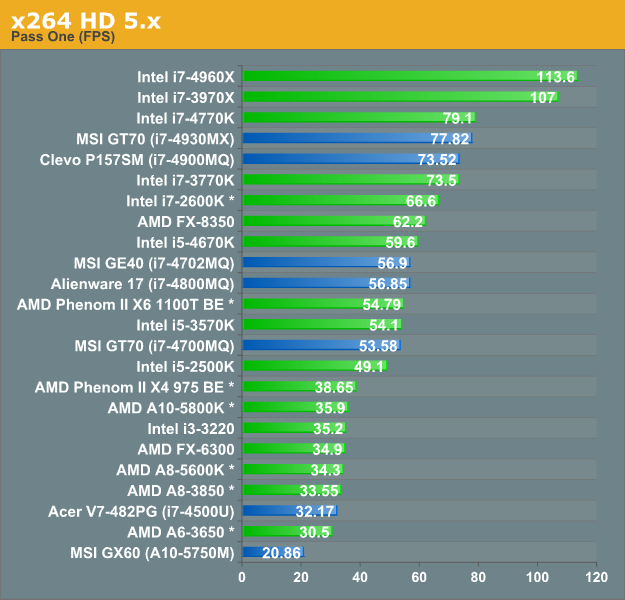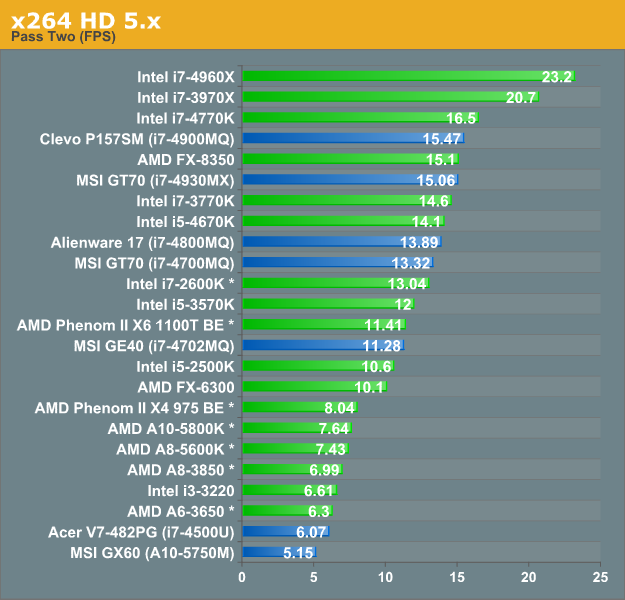Analyzing the Price of Mobility: Desktops vs. Laptops
by Jarred Walton on September 7, 2013 5:55 PM ESTCPU/General Performance Discussion
With that out of the way, let’s focus on the remaining two areas, starting with CPU performance. I’ve grabbed several generations of desktop CPUs from both AMD (K10.5, Llano, Trinity, Bulldozer, and Piledriver – we don’t currently have Richland results, but they’re generally 5-10% higher than Trinity) and Intel (Sandy Bridge, Sandy Bride-E, Ivy Bridge, Ivy Bridge-E, and Haswell) and combined those results with the latest mobile CPUs (Haswell quad-core, Haswell ULT, and Richland). We’ve got two benchmarks that are common to our CPU and laptop we’re going to look at: Cinebench 11.5 (single- and multi-threaded) and x264 HD 5.x video encoding (first and second pass).
Unfortunately, we don’t have results for all of the desktop CPUs in x264 HD 5.x, though you can get an idea of where they should fall by looking at the x264 HD 3.x results. We’ve gone ahead and used the x264 3.x scaling for desktop CPUs where we don’t have 5.x results, and marked those results with an asterisk (*) in the following graphs. The first pass tends to be about 2x as fast with x264 HD 3.x, unless you have four cores with Hyper-Threading in which case scaling is closer to 1.5x (and 6-cores results in scaling of around 1.08x). The scaling in the second pass is much more uniform, with 3.x being around 2.75x as fast as 5.x. Since we’re already comparing apples and oranges in a sense (desktop and laptops, with different motherboard, RAM, etc.) we’re really just interested in an estimate of performance. Do not take the following charts as 100% definitive, but rather as a baseline comparison.




It used to be that if you wanted top CPU performance, a desktop system was absolutely required. These days, for lightly-threaded workloads the gap has narrowed substantially: a moderate i7-4700MQ Intel Haswell processor will get you around 85% of the performance of the desktop i7-4770K, and the i7-4930MX will get you 98% of the single-threaded performance. Even the i7-4500U Ultrabook is able to deliver 75% of the 4770K performance. Move to heavily threaded workloads and the gap grows (particularly if we included the hex-core processors), but the 4700MQ and 4930MX are still 81-87%/91-98% of the 4770K performance – it’s the dual-core mobile CPUs that really take a hit, with the i7-4500U delivering roughly one third (37-41%) the performance of the 4770K. Of course, if you’re not doing CPU intensive tasks like video encoding, the single-threaded performance will be the more pertinent result.
The AMD side of the equation isn’t nearly so rosy, at least if you want performance anywhere near that of a top-end desktop. Llano, Trinity, and Richland have been far more focused on reducing power use and increasing integrated graphics performance than on boosting CPU performance. The result is that in single-threaded performance, the fastest mobile Richland APU is less than half the performance of the 4770K, and in the multi-threaded tests it’s 26-31% of the 4770K performance. Comparing mobile Richland to desktop AMD parts doesn’t really help much either: in the single-threaded Cinebench result, it basically matches the Llano A6-3650 and is 12% slower than the A8-3850, while it trails most of the other AMD CPUs/APUs by nearly 30%. Move to multi-threaded workloads and it’s only able to deliver 30-60% of the more powerful AMD desktop APUs (and 60-80% of the desktop Llano APUs). Richland is still “fast enough”, but it’s definitely a value proposition as opposed to a performance option – the iGPU of Richland may be faster than HD 4000/4400/4600, but dGPUs like the GT 730M are still roughly twice as fast and available for not much more money. But we’re skipping ahead….
Summarizing the general performance of our mobile platforms, we’re able to come pretty close to the performance of desktop systems, and while there’s still a price premium in effect it’s definitely getting smaller than in the past. The least expensive laptop/notebook I can find right now with a quad-core Haswell CPU is the HP Envy 15t-j000, which you can currently get for $700 after the $100 instant discount. That will get you 8GB RAM, 1TB HDD, and Windows 8, but not too much else. Adding a 1080p LCD ($50), GT 740M ($70), and a backlit keyboard ($30) brings the total to $850. That’s roughly the same performance as a Sandy Bridge i7-2600K, and slightly faster than the Haswell i5-4670K. You can get a pre-built desktop from Newegg for $700 (which adds in an HD 7750 GPU), while a DIY system with similar specs to the laptop (e.g. no dGPU) will set you back $672 (see table below) – not including a mouse, keyboard, display, or speakers.
| Mainstream Desktop PC | ||
| Component | Description | Price |
| CPU | Intel Core i5-4670 (Quad-core, 3.4-3.8GHz, 6MB L3, 22nm, 84W) | $200 |
| Motherboard | ASRock Z87 Pro3 LGA-1150 | $115 |
| Memory | 2x4GB DDR3-1600 CL9 1.5V RAM | $65 |
| Storage | Seagate 1TB 7200RPM HDD | $70 |
| Optical Drive | SATA DVDRW (Lite-On) | $18 |
| Case | Antec Three Hundred | $60 |
| Power Supply | Seasonic 350W 80 Plus Bronze | $44 |
| Operating System | Windows 8 64-bit (OEM) | $100 |
| Total | $672 | |
In other words, if all you want is a computer for moderate needs, it’s not hard to see why laptops are displacing desktops for many people. In this case we’re able to get the same level of performance for potentially less money (depending on whether or not you need to buy an LCD, keyboard, and mouse). Desktops are still going to be far more upgradeable, and you can take a “basic use” desktop like the one above and upgrade it with a high-end graphics card for $300 to get a potent gaming PC. Adding more memory, more storage, upgrading the motherboard and CPU, etc. are all things that you can do with a desktop, whereas with laptops typically only the RAM and storage can be upgraded/replaced and if anything else breaks you’ll have to send it in for repairs (or buy a new laptop).p
We can go down to lower price points of course – there are desktop PCs with moderate hardware starting at just over $300, and they’re still more upgradable than laptops, but similar performance laptops can be had for about the same price, especially if you look at some of the previous generation hardware. It’s mostly a question of how much performance you want/need, and whether you’re interested in the potential to upgrade components down the road. If you don’t have any plans of adding more RAM, storage, or a GPU the case for laptops is stronger now than ever. And let’s not forget that most laptops have an idle power draw south of 20W, compared to 40-60W for a typical desktop (and that’s not including the display or speakers on the desktop), so the energy factor also favors laptops.










110 Comments
View All Comments
puppies - Saturday, September 7, 2013 - link
Second sentence should be used not uses.brucek2 - Saturday, September 7, 2013 - link
AnandTech, where user comments go much, much further. What a treat to get such a thorough reply to a few readers questions, and barely 24 hours later.My only quibble might be that I believe all these performance numbers are at stock speeds? A high end desktop could probably get another 10-30% from OC'ing, while a high end laptop would probably get either no or significantly less boost due to less cooling capacity (and less support from the BIOS, mobo, etc.)
Even so I don't think that really changes the overall picture. I was surprised to see the single threaded performance range being so narrow (only ~2x), and agree that for most use cases, most of the time, even the bottom end is going to be fine. The much greater 6x+ range on the multi-threaded / gaming side is of course the big factor for those that need it. And its great to see a trusted source call out (even if gingerly) the practice of using the same price and same name for a mobile GTX 780 that is barely in the same league as the desktop counterpart, even at stock speeds.
I also couldn't agree more on the SSD comments. Especially on budget laptops where the target audience is not likely to ask any questions about the storage subsystem, there is a real likelihood of getting the slowest possible hard drive, which can end up making bottlenecks even out of situations where SSD users long ago forgot that storage was even a factor. A situation usually made worse by the likely ton of bloatware that will consume the limited hdd bandwidth by loading and updating itself, downloading ads, etc. I remember my first high end gaming laptop, I thought the cpu was defective or being improperly throttled until I finally realized that yes the 2.5" 5400 rpm hd was really that bad and causing that much trouble.
Anyway thanks for a great article, I know I'll be directing some shoppers to it over the coming months and I hope its helpful for other folks as well.
nerd1 - Saturday, September 7, 2013 - link
Most high performance gaming laptops allow OC'ing for both CPU and GPU, and some are even factory overclocked. Also now pretty much ALL laptops (except for some fruit-labeled ones) has one or two empty mSATA slots for easy SSD upgrade.JarredWalton - Saturday, September 7, 2013 - link
My experience with overclocking notebooks is that, at best, you might get an extra 2 bins of CPU performance on the high-end CPUs before you run into thermal limits and the CPU starts to throttle. I saw this with the Mythlogic (Clevo P157SM), where the 4700MQ was able to run at max OC (2 bins) without any issues, but the 6 bin overclocking headroom of the 4900MQ basically didn't do much for performance. Desktops can definitely overclock more, and that's another factor for some, but on mobile systems I think the benefits of overclocking are usually outweighed by the increased heat/noise.JarredWalton - Saturday, September 7, 2013 - link
As for Bruce2K, I read your comment and thought, "Yeah, I could probably do that for the readers and it should prove interesting." Thanks for the idea!nerd1 - Saturday, September 7, 2013 - link
I heard haswell and new 780M is worse than previous-gen ones in terms OC'ing. Some people claim they OC'ed their 680M to the same performance as 780M. So OC is definitely possible and can be effective on some laptops. That said, personally I never do OC'ing myself.WarrenSmith - Saturday, September 14, 2013 - link
Love my job, since I've been bringing in $5600… I sit at home, music playing while I work in front of my new iMac that I got now that I'm making it online( Click on menu Home)http://goo.gl/OHUOdW
brucek2 - Saturday, September 7, 2013 - link
I know the basic controls are often there, but can you really get the same results out of them at acceptable stability, noise, and chassis heat (ie where you place your hands) and without triggering throttling? That's great news if you can.Watwatwat - Thursday, October 10, 2013 - link
Yep but the thermal issues in a laptop just can't be avoided, theres no getting around having a tiny heatsink and basically almost no fan. Also overclocking on a gaming laptop is a great way to turn 2 hours of battery life into 1;) Last I checked overlocking doesn't result in linear increase in power consumption.WinterCharm - Thursday, September 12, 2013 - link
I did manage a 19% GPU overclock on my laptop... and while performance improved, it'll never be anywhere near what it is on a desktop.